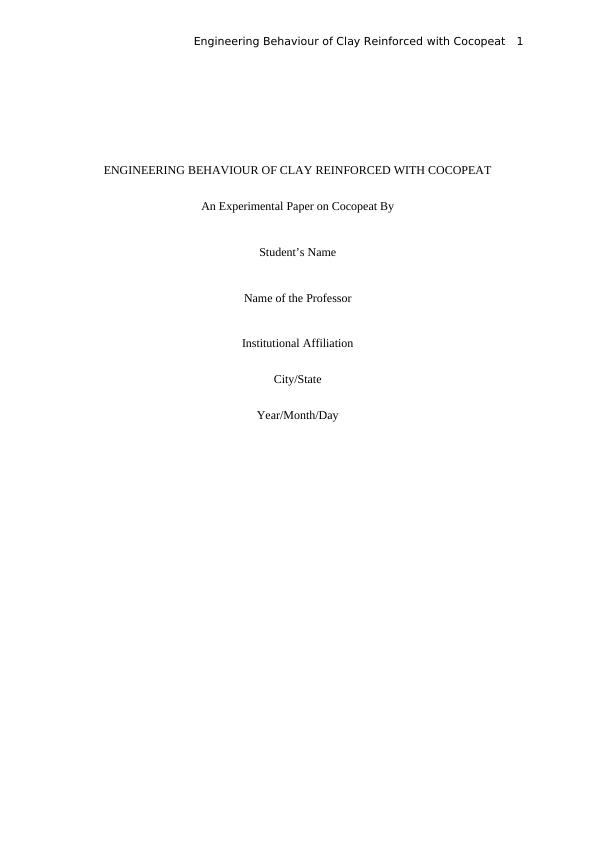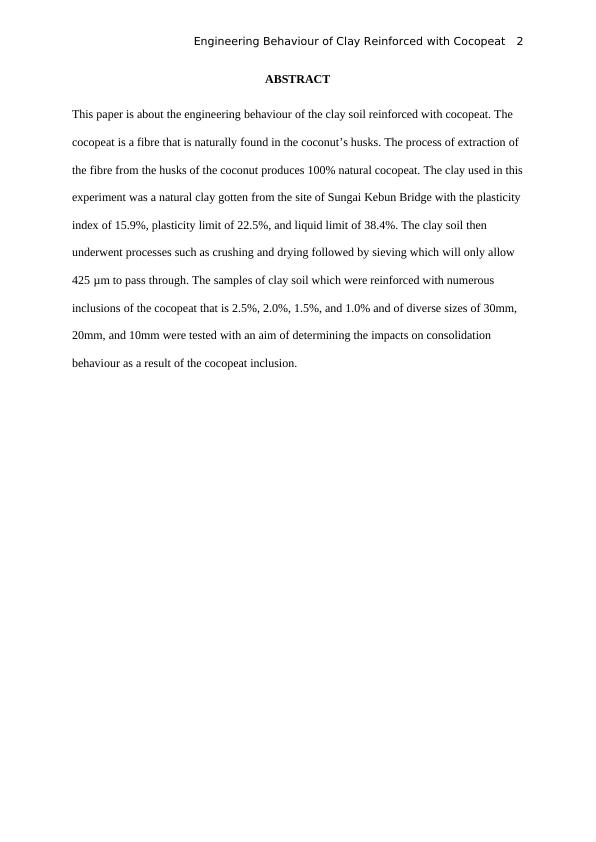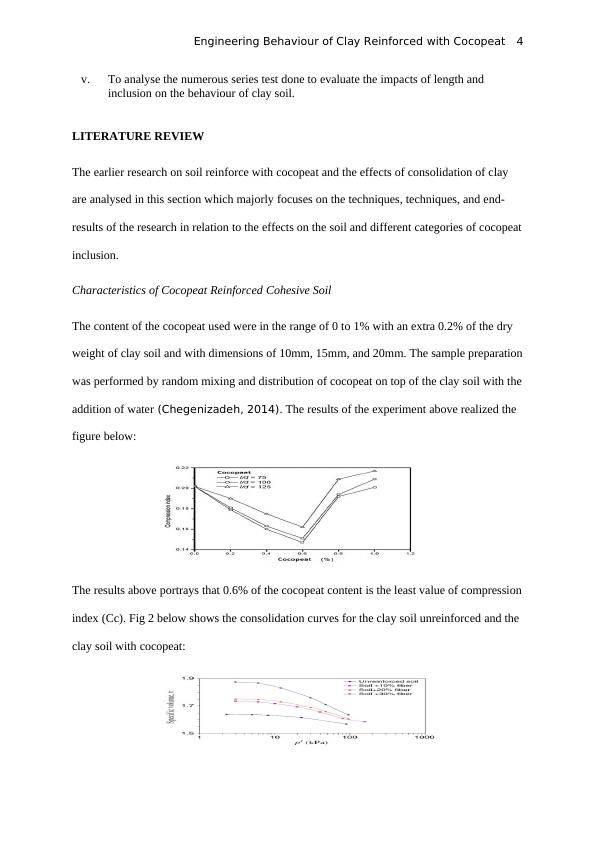Engineering Behaviour of Clay Reinforced with Cocopeat
11 Pages2462 Words39 Views
Added on 2020-04-21
Engineering Behaviour of Clay Reinforced with Cocopeat
Added on 2020-04-21
ShareRelated Documents
Engineering Behaviour of Clay Reinforced with Cocopeat 1
ENGINEERING BEHAVIOUR OF CLAY REINFORCED WITH COCOPEAT
An Experimental Paper on Cocopeat By
Student’s Name
Name of the Professor
Institutional Affiliation
City/State
Year/Month/Day
ENGINEERING BEHAVIOUR OF CLAY REINFORCED WITH COCOPEAT
An Experimental Paper on Cocopeat By
Student’s Name
Name of the Professor
Institutional Affiliation
City/State
Year/Month/Day

Engineering Behaviour of Clay Reinforced with Cocopeat 2
ABSTRACT
This paper is about the engineering behaviour of the clay soil reinforced with cocopeat. The
cocopeat is a fibre that is naturally found in the coconut’s husks. The process of extraction of
the fibre from the husks of the coconut produces 100% natural cocopeat. The clay used in this
experiment was a natural clay gotten from the site of Sungai Kebun Bridge with the plasticity
index of 15.9%, plasticity limit of 22.5%, and liquid limit of 38.4%. The clay soil then
underwent processes such as crushing and drying followed by sieving which will only allow
425 μm to pass through. The samples of clay soil which were reinforced with numerous
inclusions of the cocopeat that is 2.5%, 2.0%, 1.5%, and 1.0% and of diverse sizes of 30mm,
20mm, and 10mm were tested with an aim of determining the impacts on consolidation
behaviour as a result of the cocopeat inclusion.
ABSTRACT
This paper is about the engineering behaviour of the clay soil reinforced with cocopeat. The
cocopeat is a fibre that is naturally found in the coconut’s husks. The process of extraction of
the fibre from the husks of the coconut produces 100% natural cocopeat. The clay used in this
experiment was a natural clay gotten from the site of Sungai Kebun Bridge with the plasticity
index of 15.9%, plasticity limit of 22.5%, and liquid limit of 38.4%. The clay soil then
underwent processes such as crushing and drying followed by sieving which will only allow
425 μm to pass through. The samples of clay soil which were reinforced with numerous
inclusions of the cocopeat that is 2.5%, 2.0%, 1.5%, and 1.0% and of diverse sizes of 30mm,
20mm, and 10mm were tested with an aim of determining the impacts on consolidation
behaviour as a result of the cocopeat inclusion.

Engineering Behaviour of Clay Reinforced with Cocopeat 3
INTRODUCTION
Background Information
Soil can be defined as the particles of minerals that have been formed through the process of
rock weathering. The clay soil is characterized by low permeability because of its high water
holding capacity. It is for this reason why the clay soil possesses great challenges to the
construction and engineering industries globally and it is not recommended for carrying or
holding heavy loads of any construction above the soil.
Problem Statement
The major reason behind the ground improvement is to enhance the features of the soil. Some
of the methods of ground improvement include vibrated compaction, vertical drains, lime
stabilization, grouting, and soil reinforcement. Through stabilization of the condition of clay
soil, the issue of settlement can be barred. The swelling and shrinkage of the soil can be
minimized hence leading to the increase in its stability specifically for the work of
construction (Akhtar, 2013).
Aims and Objectives
The major aim of this study is to investigate the behaviour of the non-reinforced and
cocopeat-reinforced and clay soil through undertaking the consolidation test. This study will
portray how the characteristic of soil consolidation is effected by the cocopeat inclusion. For
this study to be achieved, the following are some of the objectives put in place:
i. To examine the characteristics of the clay soil in agreement to BS 1977
ii. To determine the experimental to determine the impacts of cocopeat on maximum
moisture content and optimum dry density.
iii. To evaluate a suitable method of installation of cocopeat in clay soil.
iv. To carry out numerous consolidation test through:
a) Variation in the percentage of cocopeat inclusion
b) Variation of the length of the cocopeat.
INTRODUCTION
Background Information
Soil can be defined as the particles of minerals that have been formed through the process of
rock weathering. The clay soil is characterized by low permeability because of its high water
holding capacity. It is for this reason why the clay soil possesses great challenges to the
construction and engineering industries globally and it is not recommended for carrying or
holding heavy loads of any construction above the soil.
Problem Statement
The major reason behind the ground improvement is to enhance the features of the soil. Some
of the methods of ground improvement include vibrated compaction, vertical drains, lime
stabilization, grouting, and soil reinforcement. Through stabilization of the condition of clay
soil, the issue of settlement can be barred. The swelling and shrinkage of the soil can be
minimized hence leading to the increase in its stability specifically for the work of
construction (Akhtar, 2013).
Aims and Objectives
The major aim of this study is to investigate the behaviour of the non-reinforced and
cocopeat-reinforced and clay soil through undertaking the consolidation test. This study will
portray how the characteristic of soil consolidation is effected by the cocopeat inclusion. For
this study to be achieved, the following are some of the objectives put in place:
i. To examine the characteristics of the clay soil in agreement to BS 1977
ii. To determine the experimental to determine the impacts of cocopeat on maximum
moisture content and optimum dry density.
iii. To evaluate a suitable method of installation of cocopeat in clay soil.
iv. To carry out numerous consolidation test through:
a) Variation in the percentage of cocopeat inclusion
b) Variation of the length of the cocopeat.

Engineering Behaviour of Clay Reinforced with Cocopeat 4
v. To analyse the numerous series test done to evaluate the impacts of length and
inclusion on the behaviour of clay soil.
LITERATURE REVIEW
The earlier research on soil reinforce with cocopeat and the effects of consolidation of clay
are analysed in this section which majorly focuses on the techniques, techniques, and end-
results of the research in relation to the effects on the soil and different categories of cocopeat
inclusion.
Characteristics of Cocopeat Reinforced Cohesive Soil
The content of the cocopeat used were in the range of 0 to 1% with an extra 0.2% of the dry
weight of clay soil and with dimensions of 10mm, 15mm, and 20mm. The sample preparation
was performed by random mixing and distribution of cocopeat on top of the clay soil with the
addition of water (Chegenizadeh, 2014). The results of the experiment above realized the
figure below:
The results above portrays that 0.6% of the cocopeat content is the least value of compression
index (Cc). Fig 2 below shows the consolidation curves for the clay soil unreinforced and the
clay soil with cocopeat:
v. To analyse the numerous series test done to evaluate the impacts of length and
inclusion on the behaviour of clay soil.
LITERATURE REVIEW
The earlier research on soil reinforce with cocopeat and the effects of consolidation of clay
are analysed in this section which majorly focuses on the techniques, techniques, and end-
results of the research in relation to the effects on the soil and different categories of cocopeat
inclusion.
Characteristics of Cocopeat Reinforced Cohesive Soil
The content of the cocopeat used were in the range of 0 to 1% with an extra 0.2% of the dry
weight of clay soil and with dimensions of 10mm, 15mm, and 20mm. The sample preparation
was performed by random mixing and distribution of cocopeat on top of the clay soil with the
addition of water (Chegenizadeh, 2014). The results of the experiment above realized the
figure below:
The results above portrays that 0.6% of the cocopeat content is the least value of compression
index (Cc). Fig 2 below shows the consolidation curves for the clay soil unreinforced and the
clay soil with cocopeat:

End of preview
Want to access all the pages? Upload your documents or become a member.
Related Documents
Engineering Behaviour of Coir Reinforced Clay Soillg...
|15
|4009
|326
Research Paper on Clay Soil Reinforced with Cocopeatlg...
|7
|1567
|87
Report Paper on Engineering Behaviour of Clay with Cocopeatlg...
|13
|2915
|269
Improvement of Expansive Soil Property using Rice Husk Ashlg...
|18
|4763
|90
